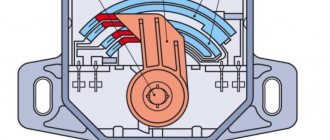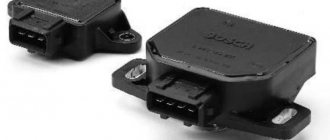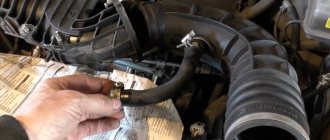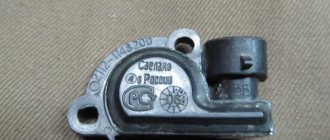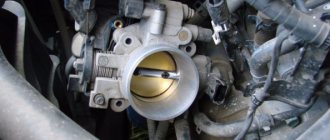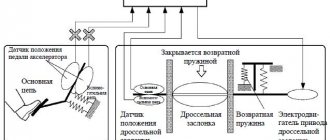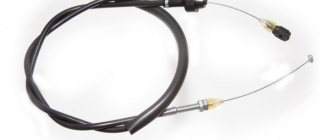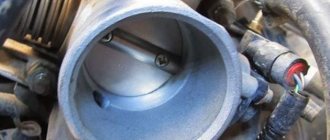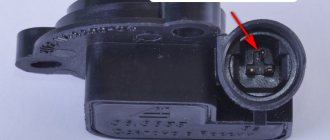Print this article Font size 16
As you know, the VAZ 2110 was produced with injection and carburetor engines. The injectors are equipped with an impressive number of sensors, the performance of which determines the functionality of important units. Therefore, if they break down, problems may arise in moving, power decreases, fuel consumption increases, and much more.
A prime example of an important sensor is the throttle position sensor. Today we’ll talk about it in more detail.
TPS design
By its design, the VAZ 2110 throttle sensor resembles an air valve - in the open position the pressure corresponds to atmospheric pressure, in the closed position it drops to a vacuum state. The TPS includes DC and AC resistors (each resistance is 8 ohms). The process of opening and closing the damper is monitored by the controller, with subsequent adjustment of the fuel supply.
The throttle position sensor can be of two types:
- film;
- magnetic or contactless.
If at least one symptom of a malfunction occurs in the functioning system of this sensor, then fuel may be supplied to the engine either in excess or in deficiency. Such malfunctions in engine operation are reflected in the engine of the VAZ-2110 car and on its gearbox.
Characteristic symptoms of a malfunctioning TPS condition
Thanks to the correct functioning of the throttle position sensor, the fuel system of the VAZ-2110 car engine works with a smoothing effect. That is, the vehicle moves smoothly, and the gas pedal responds well to pressure. Therefore, a malfunction of the TPS can be noticed almost immediately by the following signs:
- Poor engine starting.
- Noticeable increase in fuel consumption.
- The car's movements are intermittent.
- The idle speed of the engine is noticeable when running.
- The Check e light comes on on the dashboard
- The car accelerates poorly due to delays in acceleration.
- Popping sounds are heard in the intake manifold.
Of course, these signs of a faulty sensor may not all be observed at once. But even if you notice only one of the above symptoms, it is worth carrying out computer diagnostics of the vehicle at a service center.
The design and principle of operation of the throttle assembly
The device is designed to regulate the air supply to the engine and ensure its operation at idle speed. The node is a structurally complete element. Located between the air filter and the intake manifold, and consists of the following components:
- Aluminum housing with pipe.
- Adsorber fitting.
- Throttle sensor for VAZ 2110 (TPS).
- Crankcase ventilation connection
- Idle speed regulator.
- Throttle control sector, with cable fastening mechanism.
- Inlet and outlet heating fittings for remote control.
- Throttle valve.
The operating principle of the remote control is briefly as follows. The air, having passed through the filter and mass air flow sensor, enters the throttle body pipe, and then through the open damper into the engine cylinders. More precisely, into one of them, the one where the intake stroke occurs. The throttle valve is connected to the gas pedal by a cable, so the driver regulates the air supply. True, this alone will not make the car go faster. The working mixture is not only air, but also gasoline, which is forced into the cylinders. In order for the ECU to supply more fuel to the injectors, it is necessary to press the gas pedal and convert it into an electrical signal. For this purpose, a VAZ 2110 throttle sensor is installed in the injector. We’ll talk about it in more detail a little later, but for now let’s look at the operation of the unit as a whole.
The gas pedal is released, the throttle is closed and the engine, it would seem, should stall. However, it continues to work if, of course, the ignition is turned on. This happens thanks to the idle speed sensor. Through it, the minimum amount of air required for stable engine operation is supplied. The connection with the adsorber allows the “ten” to comply with the Euro-3 standard. The throttle body heating fittings connect it to the engine cooling system. The circulation of antifreeze allows you to avoid frost on the surface of the body in frosty weather.
Principle of operation
The movable contact of the sensor is located on the same axis as the throttle valve. Its control sector is connected by a cable and rods to the gas pedal of the car. Thus, each press on the accelerator leads not only to the rotation of the damper at a certain angle, but also to the movement of the movable contact along the resistive coating. As a result, the resistance of the potentiometer changes and, as a result, the voltage at the corresponding terminal of the control unit. The ECU increases the amount of fuel supplied to the cylinders. Moreover, this will happen simultaneously with the opening of the throttle valve. Both events are synchronized in time, and the mixture that is optimal at the moment enters the cylinders. Therefore, any malfunction of the VAZ 2110 throttle sensor leads to depletion or enrichment of the composition, which makes the trip, to put it mildly, uncomfortable.
Location and principle of operation of the meter
The sensor is installed on the throttle valve block and is mechanically connected to its axis. Thanks to this, the device is able to solve 3 problems:
- inform the controller at what angle the throttle is currently open;
- signal that the air supply is completely closed (the driver has released the accelerator pedal);
- monitor the speed at which the damper opens.
Based on this information, the electronic powertrain control unit (ECU) makes a decision to increase or decrease the fuel supply and fuel injection for intense acceleration when the gas pedal is sharply pressed.
Reference. Two types of TPS are installed on cars: resistive and non-contact. The first ones are cheaper and therefore are found on all budget cars. The latter are more reliable and more expensive, and are installed on cars of medium and high price categories.
The operating algorithm of the resistive sensor is as follows:
- At idle, the damper is closed and air flows into the engine through a separate channel. The voltage at the output of the device does not exceed 0.5 volts; the controller supplies fuel to maintain engine idle speed.
- When the driver presses the gas pedal, the sensor slider moves along the resistive film. The resistance of the electrical circuit into which the device is connected in series decreases.
- The ECU “sees” the increase in voltage in the meter circuit, makes a calculation, prepares the air-fuel mixture in the required quantity and supplies it to the cylinders. The maximum voltage at wide open throttle is about 4.5 V.
- When the driver sharply presses the accelerator pedal, the controller notes a similar voltage surge and delivers a portion of the enriched mixture for dynamic acceleration.
Note. The operating voltage values are indicated for a common Russian car - VAZ 2110.
The non-contact throttle position sensor functions identically. The difference lies in the method of influencing the electrical circuit. A resistive device changes resistance using a slider moving across the film, while a non-contact device changes resistance due to the magnetic-resistive effect. Thanks to this principle of operation, the TPS lasts much longer and does not create problems for the owner of the car.
We recommend: How to install bi-xenon H4 with your own hands: diagrams and connection sequence
What affects the operation of the throttle position sensor?
TPS (another name for TPS) is designed to determine the position angle of the throttle valve (installed on its axis) and transmit the readings taken to the ECU. It also monitors the speed of movement of the damper (when the gas pedal is pressed sharply) and the moments when it is in its extreme positions.
A lot depends on these readings - the electronic control unit, based on the data received, forms the correct ignition timing under certain engine operating conditions, and issues commands to supply fuel in the required dosage. All this affects the formation of the optimal fuel-air mixture, and, accordingly, the power performance of the engine.
Also, based on the data received, the ECU adjusts the operation of electronic systems: ABS, ESP, cruise control, traction control and others.
Is your VAZ 2110 throttle sensor connected to ground?
- Carefully disconnect the electrical connector from the VAZ 2110 throttle sensor.
- Check the connector and terminal for dirt or damage.
- Set the multimeter to a suitable mode, for example, 20V on the DC voltage (DCV) scale.
- Turn the ignition key to the ON position, but do not start the engine.
- Connect the red multimeter probe to the positive terminal of the battery, indicated by the “+” symbol.
- Touch the black probe of the multimeter to each of the three electrical contacts of the wiring connector that connects to the TPS.
* One of the contacts, when touched, a voltage of about 12 volts appears on the multimeter screen, is the ground contact. Pay attention to the color of this wire.
*If none of the terminals indicate 12 volts, this is a sign of a defect in the wiring that goes to the throttle position sensor. The sensor is not grounded, so it cannot work properly. In such a situation, you need to solve the wiring problem.
- Turn off the ignition.
Replacement
In fact, changing this sensor is insanely easy. So don't rush to send your car to a service station. Everything can be done with your own hands, the quality will not suffer from this.
- To remove the throttle position sensor, you first need to find it.
- As we have already noted, the desired unit is located on the side of the throttle pipe on the throttle valve axis.
- Having found the element, pick up a shaped screwdriver.
- Using this simple tool, unscrew a couple of bolts that hold the device.
- Pay special attention to the gasket that is available under the old regulator. We do not recommend using it again; it is better to immediately buy a new one. Often the gasket is already included with the throttle sensor itself.
- After removing the old sensor, you can slightly clean the place where it is installed if there is dirt there.
- Next, a new sensor is installed along with a new foam gasket and the bolts are tightened.
- Try to tighten the fasteners as far as possible, otherwise the new throttle sensor will quickly lose its effectiveness. The work will have to be done again.
- There is no need to make any adjustments after replacement.
- The zero mark on the controller will determine that the throttle is completely closed.
Foam pad
What to choose?
When replacing, many more or less experienced car owners have a question about which regulator is better to install. After all, there are two types.
| Sensor type | Peculiarities |
| Film-resistive | These sensors are usually factory installed. The service life of such a throttle position sensor is stated to be about 55 thousand kilometers, but in practice it has to be changed more often |
| Contactless | The operation of such a device is based on the magnetic-resistive phenomenon; a Hall element is used. The cost is noticeably higher than the first option, but it is unlikely to have to be changed. Huge resource, high reliability |
In pursuit of savings, many forget about the importance of quality. But it should be in the first place when choosing spare parts when repairing a car.
TPS is an important, but easy to replace device. The repair operation will take you no more than an hour, even if you are just beginning to learn the joys of repairing your car yourself.
But under no circumstances delay repairing the sensor, otherwise this may negatively affect the operation of the engine, its service life and the cost of fuel, which you will overuse due to incorrect data from the sensor to the ECU.
Communication of the throttle valve with other automotive systems of the VAZ-2110
The throttle valve of a VAZ-2110 car is a component of the engine intake system and is directly connected to a large number of other vehicle systems. These include the following systems:
- directional stability;
- anti-blocking;
- anti-slip;
- anti-slip;
- cruise control.
In addition, there are those systems that are controlled by the electronics of the gearbox. After all, it is this throttle valve that regulates the flow of air into the car system and is responsible for the quality composition of the fuel-air mixture.
Evidence of pollution
Don't forget that the throttle valve can become dirty. Signs of this are the following criteria: the engine begins to stall, lose speed, the engine starts with difficulty, at the minimum speed of the car, jerking begins. Always check the throttle assembly for causes of problems. Damper contamination occurs in many cases. Settlement occurs on the walls of the mechanism, entering the assembly due to ventilation of gases. Another reason is poor filter performance.
The VAZ 2114 starter does not turn - the main reasons
Typical TPS problems
A malfunction of the throttle sensor can be determined by the following symptoms:
- increase in speed intensity when the load is off;
- deterioration of dynamic performance;
- the appearance of jerks when picking up speed;
- sudden stopping of the engine in neutral;
- warning light with a light bulb.
In addition, there are other malfunctions. One of the most common is a decrease in the base coating thickness in the initial part of the slider stroke. This prevents the linear voltage level of the output signal from increasing. Another causal relationship may lie in the failure of the movable core. The breakage of one tip contributes to the appearance of a large number of burrs at the base. As a result, others also break, causing the slider to lose contact with the resistive part.
You can test the throttle sensor yourself by following these steps. The first step is to start the ignition; if the warning light does not light up, then we take the converter directly. Using a multimeter, you should measure the potential difference between “−” and the slider wire. The obtained parameters should not be higher than 0.7 V.
Next, you need to expand the sector to fully open the damper. Then you should recheck the voltage again. The readings must be at least 4 V. After this, you need to turn on the ignition and remove the connector. Again measure the resistance at the point of contact of the slider with one of the terminals. While scrolling the sector, monitor the multimeter readings.
The pointer should be moved gently and slowly, since shocks and sudden vibrations indicate a breakdown. The smooth operation of the device depends on the condition of the film resistor.
There are several types of throttle position sensor: film-resistive and non-contact. The first of them is installed by the manufacturer, the second is chosen by the car owner while driving and operating the car. The service life of the TPS may vary depending on the quality and adherence to technology in the manufacture of the device. The standard unit may not need to be changed even for 60,000 km, and sometimes it requires replacement even after 5,000 km.
When purchasing a throttle sensor, the price depends on the choice of its type:
- Film-resistive ones are the most frequently purchased among motorists due to their budget price, but their service life practically does not stand up to criticism;
- Contactless - at a higher cost (almost twice) the long period of use covers all costs. The high-quality operation of the device is due to the principle of magnetoresistance. When purchasing, you should be aware that this type of device operates at a DC voltage proportional to the throttle valve opening angle in the electric motor fuel injection system.
The sensor shaft rotates clockwise from the damper side. The service life guarantee is 3 years. Drivers do not repair the resistive sensor, but replace it with a contactless one - it is undoubtedly more reliable. Its design includes a rotor and a stator. The rotor is not affected by the magnetic field, because there is a magnet at its base. The stator is a part that is quite sensitive to the electromagnetic field. Its assembly is associated with programming, so a device of this category is often used for installation in electrical control units.
Why is it needed?
The throttle position sensor is responsible for determining the current throttle position. Depending on this, the fuel supply system changes the amount of fuel supplied under one or another operating mode of the power unit.
If problems arise with it, you can contact a service station so as not to waste your energy and nerves. But in practice, changing the TPS yourself is quite simple, plus you will save a decent amount of money.
The desired regulator is located on the side of the throttle pipe on the throttle valve axis.
Regulator location
Features of work
The TPS is essentially a variable resistor, one output of which is supplied with 5 Volt power. The second contact is connected to ground, and the third is connected to the controller.
When you press the gas pedal, the voltage changes. The sensor monitors the output voltage on the controller, thereby regulating and monitoring the quality of the supplied air-fuel mixture. This directly depends on the opening angle of the damper itself.
If for some reason this regulator fails, a catastrophe will not occur, since another sensor, the mass air flow sensor, will temporarily take over its functions.
This does not mean at all that the TPS can not be changed. Each regulator has its own functions, so there is no point in transferring the tasks of the TPS to the MAF.
Now let’s talk about how to check the throttle position sensor on a VAZ 2110
- Turn on the ignition. Using a voltmeter, we check the voltage between the minus and the slider contact. The voltmeter readings should not exceed - 0.7 V.
- Rotate the plastic sector, thereby fully opening the throttle valve. Next, check the voltage again. You should have at least 4V.
- Next, turn off the ignition completely and pull out the connector and check the resistance between the slider contact and the terminal (any).
- Gradually turning the sector, watch the voltmeter; its readings should change. The arrow should move slowly and smoothly; if you notice jerking, we conclude that the TPS . which needs to be replaced.
Accurate diagnosis of element condition
When the TPS begins to function incorrectly or fails completely, the fuel supply process is disrupted during sudden acceleration of the car.
Therefore, the first sign of sensor failure is jerks and dips when attempting dynamic acceleration.
Secondary symptoms look like this:
- when coasting downhill and the gear is engaged, the engine may stall and start again, causing jerking;
- the engine may stall either when you sharply press the gas pedal or when you release it;
- fuel consumption increases.
The listed signs are of a general nature. Therefore, a more accurate check is needed to verify that the TPS is faulty or, conversely, to exclude it from the list of parts responsible for changing the behavior of the car.
An accurate check of the element’s condition is carried out with a special device - a multimeter, equipped with needle-shaped contacts. First of all, you should make sure that the “Check Engine” sign is not lit on the dashboard, which indicates a breakdown in another place, and that the damper sensor has nothing to do with it. The further procedure is as follows:
- Switch the multimeter to resistance measurement mode and, with the ignition off, detect the negative wire.
- Turn on the ignition, set the switch to voltage measurement mode and check it at the output of the sensor. The value should not exceed 0.7 V.
- Manually open the damper slowly. The voltage should also increase smoothly and, when fully opened, remain at a level of at least 4 V.
- Turn off the ignition and connect the contacts to the input and output wires, take measurements in ohmmeter mode. Turn the valve smoothly and make sure that the chain resistance decreases without jerking.
Why did the VAZ TPS fail?
- The most common cause of failure is the disappearance of the base coating at the beginning of the slider stroke. As a result of this phenomenon, a linear increase in the output signal voltage does not occur.
- The second possible cause of a faulty throttle position sensor is a failed moving core. Damage to one of the tips can result in scuff marks on the substrate, after which the remaining tips fail. The contact between the resistive layer and the slider disappears.
Possible faults
The contact-type sensor is quite reliable, and according to the designers’ plans, it should last at least 50,000 km. This is ideal under average operating conditions. In practice, it often fails before reaching half of its intended lifespan. Like any mechanics, the controller is very demanding regarding various clearances, frequency and speed of movement of the slider. The situation is complicated by the difficulty of diagnosis. The main symptoms of a malfunction of the VAZ-2110 throttle sensor are very similar to damage to many other components of the car. However, symptoms of TSD damage may include the following:
- deterioration of engine dynamic characteristics;
- jerking during intense acceleration;
- stopping the engine when changing gears;
- “dips” when sharply pressing the gas pedal.
As already noted, the weak point of the TPS is the mechanical moving contact. The resistor slider, moving across the resistive layer, damages it. The thin coating simply rubs off, the contact deteriorates, making further operation of the car problematic. In addition, the moving contact itself may break. In this case, the engine almost does not respond to the gas pedal.
In any case, the TPS cannot be repaired, and there is no point in restoring it. The price of the sensor does not exceed 300 rubles. True, first of all, you need to make sure that it is he who is faulty.
The main signs of failure of the TPS
If the device is faulty, then error p0120, which was mentioned above, may appear, as well as other errors indicating that there are deviations in the operation of the sensor: P2135, P0222, P0122, P0223, P0123, P0220, P01578. The errors themselves are not displayed on the dashboard, only the “Check Engine” light comes on, they can be seen on diagnostic scanners, mobile devices or a laptop (more on this later).
As for error P2135, it is typical for modern cars with electronic remote control position control. Its full name is “Mismatch of readings from sensors No. 1 and No. 2 of the throttle position.” Occurs when there is increased resistance in the circuit of one of the wires (there are four of them). About its reasons in the next section.
Other signs of TPS malfunction:
- Floating speed, at idle the car shakes violently or stalls. A sharp jump in rpm up to 2000 - 3000.
- The dynamics of the car drops, especially during acceleration (dips, jerks), towing, climbing a mountain, transporting goods; as people say, the engine does not pull. This also happens due to the unstable operation of the automatic transmission, everything is interconnected. Or, conversely, when you press the gas pedal slightly, the car accelerates sharply.
- Increased fuel consumption - appears immediately after the sensor malfunctions.
- When shifting to a higher or lower gear, including neutral, the engine stalls.
- The machine switches to emergency mode, the crankshaft rotation speed does not exceed 1500 rpm, since the damper in this mode is only slightly open by 6-7%.
The same signs indicate a malfunction of the throttle valve, the condition of which is important to periodically check and, if necessary, clean.
Causes of malfunction of contact sensors
The main reason for failure is wear of the resistive tracks, leading to a complete or partial break in the electrical circuit. This leads to the transmission of incorrect data to the ECU.
Causes of malfunction of contact sensors:
- Wear of the resistor layer leads to loss of electrical contact. This can happen either at the beginning of the slider’s movement (typically when the voltage at the sensor output is low), or on another section of the tracks.
- Broken or worn tip.
- Wear of drive gears.
- Short circuit of signal or electrical circuits.
- Broken wiring, especially for VAZ cars, whose wires are not reliable.
- Oxidation of contacts and contamination of connectors.
Most causes can be diagnosed visually after disassembling the device and using a multimeter.
Regarding error P2135, which was mentioned in the previous section, its causes:
- poor ECU contact ground;
- oxidation of contacts in the connector;
- main relay malfunction;
- short circuit and other reasons.
Problems with the VAZ 2110 throttle sensor and their diagnosis
As you know, eternal parts for cars have not yet been invented. And the breakdown of the TPS can be foreseen; for this you need to inquire about the possible reasons for the failure of this part. Here are the main ones:
- Abrasion of the sprayed base layer, which serves to move the slider (the result is incorrect TPS readings).
- Failure of the movable type core (the result is deterioration of the contacts between the slider and the resistive layer).
How can you figure out problems with this sensor yourself? To do this, you can independently diagnose the operation of your diagnostics:
- Listen to the VAZ-2110 engine idling:
- the breakdown is obvious if you notice that its speed is in a “floating” state;
- Quickly release the gas pedal:
- a malfunction is present if the engine stops after this action.
- Pick up speed:
- There is a problem with the TPS if the car starts to move jerkily, which indicates an incorrect supply of fuel to the system.
Experts say that most often the sensor fails when the resistive track is heavily contaminated or is completely broken. To verify the opposite, you need to check the working condition of the TPS.
Test with a multimeter (preferred method)
Check procedure:
- Turn on the ignition.
- Check if power is supplied to the sensor. To do this, disconnect the chip and measure the voltage readings on the wires suitable for the sensor. To do this, set the switch on the device to the “20V” position and take the readings (the norm is 4.5-5.5V). If there is no voltage, then we look for an open circuit or another reason.
- We check the presence of signal voltage coming from the sensor to the computer when the damper is fully closed and open. To do this, set the “-” of the multimeter to ground (engine block or battery), and connect the “+” to the third signal contact. When the throttle is closed (the gas pedal is depressed), the voltage should not exceed 0.6-0.7V. When fully open (the accelerator is fully depressed) - at least 4V.
- Next, we check for the presence of surge voltage when moving the damper between the “closed” and “fully open” positions. To do this, use an additional wire, which you insert into the Pin of the wire going to the ECU, and connect the other end to the plus of the device. Place the contactor back on the sensor. Gradually press the gas pedal or pull the cable and monitor the instrument readings. The voltage should increase and decrease smoothly. If jumps in U occur, this means that the resistor tracks have worn out in some places and the TPS must be replaced.
POPULAR WITH READERS: What is a contract engine, you need to know this
You can also check the sensor by measuring its resistance. For this, a multimeter switched to the appropriate mode is also used. Readings are taken between the negative and signal contacts. For ease of work, the product can be removed.
Standard readings for VAZ models:
- The damper is closed – 1.5 kOhm.
- Open – 7.5 kOhm.
For example, the Niva Chevrolet has different regulatory indications:
- The damper is closed – 2.4 kOhm.
- Open – 8.2 kOhm.
Therefore, see the operating and repair manual for your car model for voltage and resistance data.
The process of changing resistance should also occur smoothly without jumps. To do this, rotate the sensor mount.
Checking the VAZ 2110 throttle sensor with a diagnostic tool
The words “diagnostic tool” sound loud, but in fact, it will be enough to purchase an ELM327 auto scanner or Scan Tool Pro running on the same chip and install special software, for example, OpenDiag, on a smartphone (Android) or iPhone (iOS).
You can also carry out a complete diagnostic of the car via a laptop. Or use the AVTOAS-F16 CAN multi-system scanner.
But in short, the essence of using scanners is to connect to the computer and, using special software, see the error numbers registered in it.
Connection is possible via: USB cable, WI-FI, Bluetooth. But it is important to know that some ECUs, especially on older cars, do not support WI-FI and Bluetooth protocols and the ELM327 scanner can only be connected to them via USB with a USB to MicroUSB Adapter. Accordingly, you need to purchase a wired scanner model.
It is better to use scanners with a 32-bit chip; they provide more opportunities for diagnosing a car.
Possible errors associated with the TPS and the electrical circuit were mentioned above, but other errors associated with unstable operation of the engine and electronic systems of the car may also be registered in the ECU. Some of them can be reset, for example, “motor overheating”.
The advantage of using a scanner is monitoring the operation of the sensor in real time. To do this, turn the throttle while squeezing the gas pedal. The program will display changes in voltage and inclination angle. Sudden voltage surges will indicate a problem.
Evidence of pollution
Let's look at the signs that indicate a malfunctioning throttle valve:
- Revolutions. You sharply release the gas pedal, but the engine is in no hurry to switch to idle speeds from high speeds. Instead of a smooth reset and acceleration, the engine begins to shake, it either stalls completely, or with great difficulty restores the required speed;
- Launch. Your VAZ has difficulty starting cold, and sometimes you cannot quickly start even a hot engine. There may be other reasons for this phenomenon, but the fact that the throttle valve is to blame may be indicated by the fact that after several throttle applications (short-term presses on the gas), the engine usually starts;
- The starter spins for a long time before starting, and the smell of gasoline is heard from the exhaust pipe;
- The engine may run for a couple of minutes after starting.
Dirty throttle valve VAZ 2110
How to understand that the cause of the problem is the throttle sensor of the VAZ 2110
So:
- This device is designed to read information about its position from the gas pedal, as well as determine at what angle the throttle valve is open.
- It is located on the same axis as the damper drive, on the throttle pipe. Its service life cannot be predicted; many factors can influence device malfunctions.
- One of the most common malfunctions is increased idle speed. This happens because in the event of a breakdown, the TPS mistakenly determines the position of the damper, and its functions are transferred to another controller - the mass air flow sensor (the sensor responsible for the mass air flow).
- The problem can manifest itself in different ways. For example: the car stalls while driving or, when accelerating and picking up speed, you feel jerking. Sometimes the “XX” (idle) speed is unstable, no matter what engine operating mode you turn on. The CHECK ENGINE indicator may light up, although this does not always happen.
- It is not difficult to check the operation of the sensor: with the ignition on, you need to measure the voltage between its winding and ground with a voltmeter. In this case, the voltmeter reading should not exceed 0.7 volts.
- Then you need to turn the plastic sector by hand, thereby opening the throttle valve. The new measurement should show a voltage value of 4 volts, or slightly more.
- Now you need to turn off the ignition and measure the resistance. Having opened the connector, connect an ohmmeter between it and the slider terminal. Smoothly turning the sector, monitor the readings of the ohmmeter needle - there should be no sharp jumps.
- In case of any deviations from the norm, the VAZ 2114 throttle position sensor will need to be replaced. Moreover, if the tip is broken, or the coating of the base along the slider is worn off. For all injection VAZ cars, starting from 2108, the sensor itself and the work to replace it are identical.
How to change a part?
Replacing the throttle position sensor in a VAZ of the “tenth” family and Lada Priora is quick and easy. But there is one question - what type of sensor should I choose? The fact is that new contactless elements of increased reliability and equally high cost have appeared on the market.
They do not contain a resistive film, and use the principle of magnetic induction to operate. So, if possible, it’s better to put one in your “top ten” and forget about the troubles with TPS for a long time.
The replacement operation is performed as follows:
- Disconnect the battery and disconnect the sensor from the connector.
- Unscrew the mounting bolts and remove the part. Don't lose your foam pad unless you have a new one.
- Install the new element with gasket and connect all wires.
If diagnostics and replacement are carried out correctly, then engine operation should stabilize in all modes.
Hi all! I hope the information from this post will be useful and will be useful to someone! Good luck on the roads and a full tank!
The “symptoms” of a faulty throttle position sensor include the following:
1. Increased idle speed. 2. The engine stalls in neutral gear. 3. Idle speed floats. 4. Jerks during acceleration. 5. Deterioration in dynamics. 6. In some cases, the Check Engine light may come on.
Diagnosis of the throttle position sensor is carried out as follows:
1. Turn on the ignition, then check the voltage between the slider contact and the minus with a voltmeter. The voltmeter should show no more than 0.7 V. 2. Next, turn the plastic sector, thereby fully opening the damper, then measure the voltage again. The device should show at least 4 V. 3. Now turn off the ignition completely and pull out the connector. Check the resistance between the slider contact and any terminal. 4. Slowly, turning the sector, monitor the voltmeter readings. Make sure that the needle moves smoothly and slowly; if you notice jumps, the throttle position sensor is faulty and must be replaced.
Replacing the throttle position sensor:
1. Disconnect the wire from the “–” terminal of the battery. 2. Disconnect the block with wires from the throttle position sensor by pressing the plastic latch. 3. Unscrew the two mounting screws and remove the throttle position sensor from the throttle pipe. 4. Install the new sensor in the reverse order, but do not forget about the foam ring. The throttle position sensor does not require any adjustment, since the controller perceives idle speed (i.e. the throttle valve is completely closed) as the zero mark.
The “symptoms” of a faulty idle speed sensor include the following:
1. Spontaneous unregulated change in engine speed (sudden decrease or increase). 2. When turning on a “cold” engine, there is no increase in speed. 3. When using additional vehicle devices (heater, headlights), the idle speed is simultaneously reduced. 4. The engine stalls at idle and when shifting gears. It is necessary to remember that the readings of the VAZ 2110 injector idle speed sensor are not “readable” by the automatic on-board power system, and it is not integrated into the “Check Engine” alarm system.
Diagnostics of the idle speed controller is carried out as follows:
There are several ways to analyze the idle speed sensor, but the main ones - the simplest and most effective - are the methods described below:
1. First you need to “get” to the device, disconnect it from the connecting block of wires 2. Using the most common voltmeter, check for the presence of voltage - the “minus” goes to the engine, and the “plus” to the terminals of the same block of wires A and D. 3. Turns on ignition, and the received data is analyzed - the voltage should be within twelve volts, if less, then most likely there are problems with the battery charge; if there is no voltage, then you will have to check both the electronic control unit and the entire circuit. 4. Then we continue the inspection with the ignition on, and analyze terminals A:B, C:D one by one - the optimal resistance will be about fifty-three ohms; During normal operation of the IAC, the resistance will be infinitely high.
Cleaning the throttle sensor VAZ 2110
So, the part has been removed. Now you need to assess the condition of the gasket. If cleaning is being done for the first time, the gasket should be replaced. Cleaning is carried out using a pre-prepared product, cotton swabs and a toothbrush. We need to clean all cavities and hidden channels. The damper itself and the landing sites need to be given special attention.
The photo shows the cleaning process using a special liquid.
As a result, the remote control must be completely cleaned of grease and dust. Before installation, it is worth cleaning the crankcase ventilation duct. Here you will need a foot pump. It is better to perform purging with the same product.
The photo clearly shows what a cleaned unit should look like.
Cleaning Rules
Before removing and cleaning the throttle valve, you need to buy a special cleaner for it. There are many manufacturers, there is enough choice. Among the inexpensive ones, Abro is effective.
Disassembly:
- You need to remove the engine cover (decorative plastic);
- Reduce the pressure in the cooling system by unscrewing the expansion tank cap;
- Loosen the clamps and remove the hose from the forced ventilation air pipe;
- Use a screwdriver to remove the heating hoses for the remote control (it is advisable to plug them for now);
- Disconnect the cable and unscrew the fastening nuts. Now removal of the throttle assembly is possible;
- Use a cleaner to wash everything very thoroughly. Most often, it is necessary to use a needle to check whether the forced ventilation channel is coked, and also to clean it;
- Cleaning is necessary for the idle air regulator, for which it must be removed and inspected. If you find that it is jamming and adjustment is impossible, then it needs replacement;
- After washing, reassemble everything as it was. Please make sure that the gasket is intact and in good condition, then you can leave it. If this is not the case, then only replacement.
Buying a new sensor
The car manufacturer VAZ, when assembling injection cars, installs domestically produced resistive film sensors on them, which differ only in their very short service life. The price of such a device is small - within three hundred rubles, so there is no point in repairing it. Replacing the VAZ 2110 throttle sensor, in this case, will be the best solution.
Non-contact TPS
The internal structure of a proximity sensor essentially consists of a rotor and a stator. The rotor itself is made of a material that cannot be affected by a magnetic field, and a magnet is located on its base. The stator, on the contrary, is an element that ideally senses the magnetic field (the so-called Hall element). It is located at a distance from the magnet, which has a constant value, and during the assembly of the device itself is programmed in a certain way. This invention is used in the automotive industry for installation in an electronic control system. For the VAZ 2110, replacing the throttle position sensor with a non-contact version will be the best solution. Despite the fact that such devices are twice as expensive as film-resistive devices, they are much more reliable in operation and last much longer.
Examination
In addition to checking the sensor itself, pay attention to the condition of the throttle valve. Sometimes it becomes coked, and as a result its mobility is lost. In this case, symptoms similar to sensor failure will also be observed.
The simplest check of the sensor’s functionality can be done even without removing it from the car:
- To do this, turn on the ignition and measure the voltage at the TPS terminals, it should not exceed 0.7 V;
- Next, use the plastic sector to fully open the throttle. Then the voltage is measured again. The normal value is at least 4B;
- Then check the correct operation of the sensor. To do this, you need to measure the voltage at the TPS terminals when the damper moves.
- It should not jump sharply, all changes should occur smoothly. Abrupt changes indicate a malfunction of the device;
- The final check is to check the resistance between any of the terminals and the slider contact. To do this, turn off the ignition and pull out the connector. When turning the damper, this indicator should change evenly.
If you find out that the sensor is faulty, you should replace it. It is important to choose this design element correctly. The VAZ 2110 is equipped with 2 types of TPS. One of them is film resistive. This type is installed by the manufacturer, the sensor is designed for 55,000 kilometers. The other type is called non-contact. It uses a Hall sensor. This device has no restrictions on its service life. But it costs a little more.
Conclusion
. The “ten” is equipped with a familiar sensor. The same version of the device is installed on this entire family. In this regard, all signs of a malfunction of the throttle sensor on the VAZ 2110, with the exception of minor nuances, are similar on all cars with this sensor model. Timely repairs will save you from the hassle of having a poorly functioning machine.
The throttle unit (DU) is responsible for supplying air to the engine of the VAZ 2110 car. The enrichment of the fuel mixture with fresh air depends on its operation. And if the throttle assembly is damaged, then the functioning of the power plant is disrupted. If it breaks down, the remote control is replaced with a new one, but sometimes the result of a malfunction can be contamination of the unit or a broken TPS - throttle position sensor of the VAZ 2110. You can do both cleaning and replacement yourself.
Helpful advice: cleaning and changing the gasket is necessary every 50-60 thousand kilometers. This figure is suitable for almost all VAZ models. Then repairs and replacements will not be required. Cleaning will cost only 150-200 rubles.
Replacing the throttle sensor for VAZ 2110
Replacing the auto sensor takes place in several stages, it is quite simple, even a novice car enthusiast can do it. First you need to turn off the ignition and disconnect the wire from the negative terminal on the battery. Then you should press the plastic latch and also disconnect the block with the existing wires from the sensor. To completely remove the device being replaced, unscrew the two bolts using a Phillips screwdriver.
Foam rubber is used as a seal between the throttle pipe and the sensor. It is a component and also needs to be replaced. When installing a purchased device, you need to carefully tighten the mounting screws until the ring is completely compressed.
After installing the sensor, you should connect the wires. Since no further adjustment is required, the work can be considered complete. The entire process of changing the device takes no more than a quarter of an hour.
Sources
- https://ladaautos.ru/vaz-2110/osnovnye-priznaki-neispravnosti-dpdz-vaz-2110-kak-ix-proverit.html
- https://FB.ru/article/421681/datchik-drosselnoy-zaslonki-vaz—priznaki-neispravnosti-ustroystvo-printsip-rabotyi-sovetyi-po-ustraneniyu-polomki
- https://AutoTopik.ru/diagnostika-neispravnostei/priznaki-neispravnosti-datchika-drosselnojj-zaslonki.html
- https://autofakty.com/proverka-datchika-polozheniya-drosselnoj-zaslonki-dpdz/
- https://avtovx.ru/elektrooborudovanie/datchik-drosselnoy-zaslonki-vaz-2110-75/
- https://ladafakt.ru/proverka-dpdz-multimetrom-vaz-2110.html
- https://vazweb.ru/desyatka/pitanie/drosselnaya-zaslonka.html
- https://MasteraVaza.ru/elektroprovodka-i-elektrooborudovanie/datchiki/zamena-datchika-polozheniya-drosselnoj-zaslonki-na-vaz-219
- https://remontvazov.com/drosselnaya-zaslonka-zamena-chistka
Correction of a factory miscalculation
It is quite common for a throttle assembly to come out of the factory with something that cannot even be called a defect, but can still be attributed to design errors. In theory, air should flow into the space behind the throttle, for which a channel of approximately 2.5 mm is specially made.
But the whole problem is that this channel was pressed against the wall of the receiver, thus blocking the possibility of air flow. A slight modification of the throttle assembly can help in this case.
Bored channel for air flow in the throttle
To do this, just take a file and use it to make a small groove in the indicated place. 2 - 3 mm will be enough. But before doing this, it is necessary to remove the throttle.


